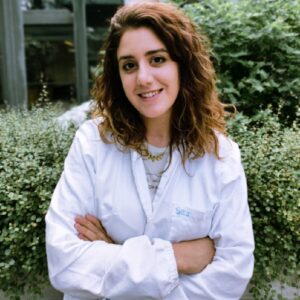Join us at the ISSCR Annual Meeting 2023
Boston, USA | 14th – 17th June 2023
Join Qkine and over 4000 scientists from around the world at ISSCR 2023 to be part of the most significant stem cell event of the year. The ISSCR meeting is a hub for discovery, collaboration and innovation and celebrates the year’s achievements in the field.
Visit us at booth 709 to learn about our portfolio of innovative bioactive proteins for stem cell and organoid culture. We will also be giving you the chance to win one of two pairs of Apple Air Pods, plus up to £1000 of Qkine credit to be redeemed against our catalogue. These prizes are only available by visiting our booth at the ISSCR annual meeting.
We are also offering an exclusive Qkine goody bag for customers who sign up before the conference and then visit our stand. Sign up by May 31, 2023 to reserve your Qkine goody bag to collect on the stand!
In addition to exhibiting, we have co-sponsored a poster with Sveva Bottini from the Bertero lab at the University of Turin on ‘Optimization of growth factors for human pluripotent stem cell culture in basal 8 media.’
Learn more about the ISSCR annual meeting 2023 by clicking here
Key details
When: Wednesday, 14th June 2023. 9:00 AM (Eastern Time) – Saturday, 17th June 2023, 7:00 PM (Eastern Time)
Where: Boston Convention and Exhibition Center
415 Summer Street, Boston, MA, 02210, United States
Registration : You can attend this event in person or virtually. All registrants will have access to the virtual meeting platform and programming on demand for 30 days after the event. (Note: not all content will be livestreamed and/or recorded for the virtual audience). You can register for ISSCR 2023 Annual Meeting here.
Sign up to reserve your Qkine goody bag
Poster abstract
Co-sponsored with Sveva Bottini


Commercial media can empower most laboratories that wish to culture human induced pluripotent stem cells (hiPSCs). Though, democratization of this technology is hindered by high costs, particularly for applications that require large scale cultures. Among homemade media, Basal 8 (B8) stands out as an attractive negligible-cost and weekend-free chemically defined formulation.
However, B8 requires homebrewing three growth factors in E. coli: TGF-B3, NRG-1, and thermostable FGF2 (t-FGF2). This represents a bottleneck for research laboratories with limited expertise in recombinant protein purification. Furthermore, B8 requires a high concentration of t-FGF2 (40 ng/mL), leading to a substantial burn rate. In all, we set out to explore sourcing options to stimulate pluripotency signaling pathways in a reproducible yet cost-effective manner. In house production of growth factors, following published protocols, was successful yet plagued by batch-to-batch variations in endotoxin levels and t-FGF2 bioactivity. We thus pivoted to testing growth factors manufactured by various commercial suppliers.
First, we compared various types of TGF-B signaling inducers, concluding that an animal-free E.coli expressed TGF-B1 has equivalent bioactivity yet higher purity and lower costs compared to mammalian cell-derived options. Animal-free TGF-B1 and TGF-B3 are both effective in B8, though at higher doses than previously reported, while Activin A is unsuitable.
Then, we tested various types of FGF2, comparing wild type versus thermostable, and full length (154 aa) versus truncated (145 aa) variants. Tag-free FGF2-G3 (a t-FGF2 patented for commercial use by Enantis/Masaryk University) outperforms homemade his-purified t-FGF2, and its higher stability in media is essential for weekend-free feeding schedules. Additionally, the truncated FGF2-G3 is more bioactive than full-length, and therefore its dosage in B8 can be optimized. Characterization of hiPSCs maintained in optimized B8 versus commercial Essential 8 (E8) via single cell RNA sequencing, immunostaining, and trilineage differentiation confirmed pluripotency.
Finally, culture of hiPSCs in optimized B8 supports robust cardiac differentiation. In all, these advances enable strong cost reduction while maintaining reproducibility of hiPSC culture.
